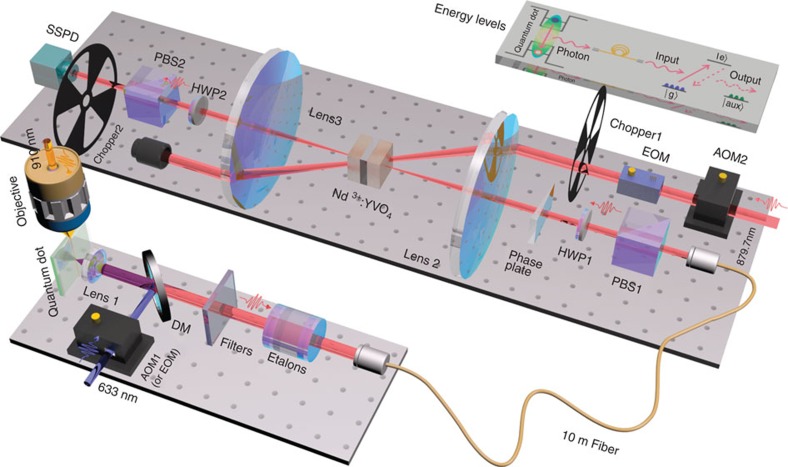Figure 1. Experimental set-up.
This experiment is performed on two separated optical tables connected by a 10-m-long optical fibre. The QD sample and the Nd3+:YVO4 crystals are spaced 5 m apart. A single QD embedded in a planar DBR microcavity is excited by a 633-nm laser, and a 910-nm laser is used to shift the wavelength of the QD emission using the local-heating effect. The QD emission is precisely shifted to the 4I9/2→4F3/2 transition of Nd3+ with the calibrated etalon. The 879.7-nm laser, which is modulated by AOM2 and electro-optic modulator (EOM) both in intensity and in frequency, is used to pump the Nd3+:YVO4 crystals to create a frequency comb according to the AFC protocol. The single photons are then stored in the crystals and retrieved after a time Tstorage. An SSPD with a low dark count is used to detect the single photons. PBS1, HWP1, PBS2, HWP2 and the phase plate are used to prepare and measure the polarization qubit when the qubit-memory experiment is performed. The arrows indicate the directions of the light beams. The AOMs (or EOM used for modulating excitation light) and the choppers are synchronized to an electrical-pulse generator to create the time sequence for this experiment. The inset shows the energy levels of the QD and the Nd3+-ions. The QD, which can contain an exciton, biexciton or a trion, emits a single photon, which is then sent to the quantum memory via a fibre, and is subsequently absorbed by the ion ensemble with a frequency comb. After the storage time, the photon is re-emitted by the ions. |g〉, |e〉 and |aux〉 denote the ground, excited and auxiliary levels of Nd3+ ions, respectively.

